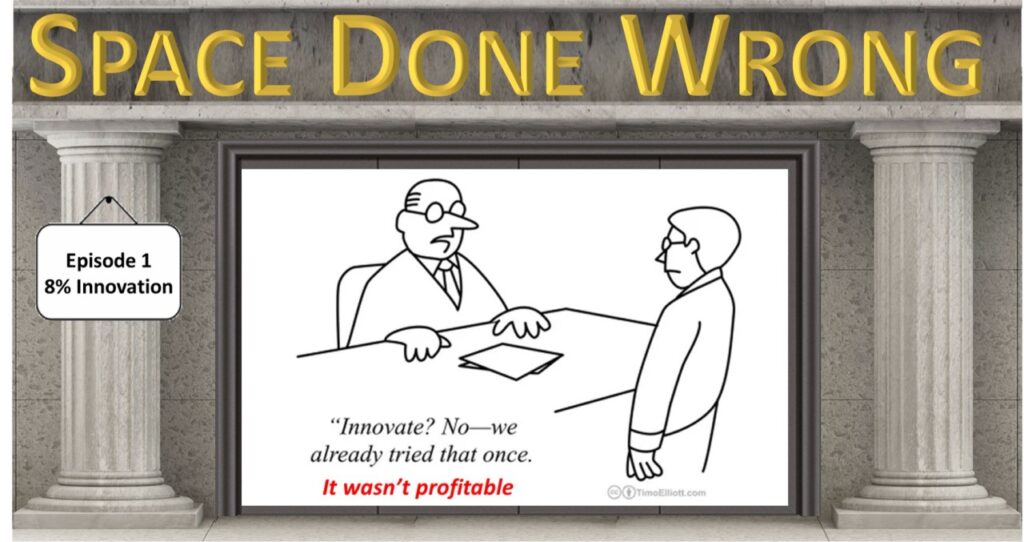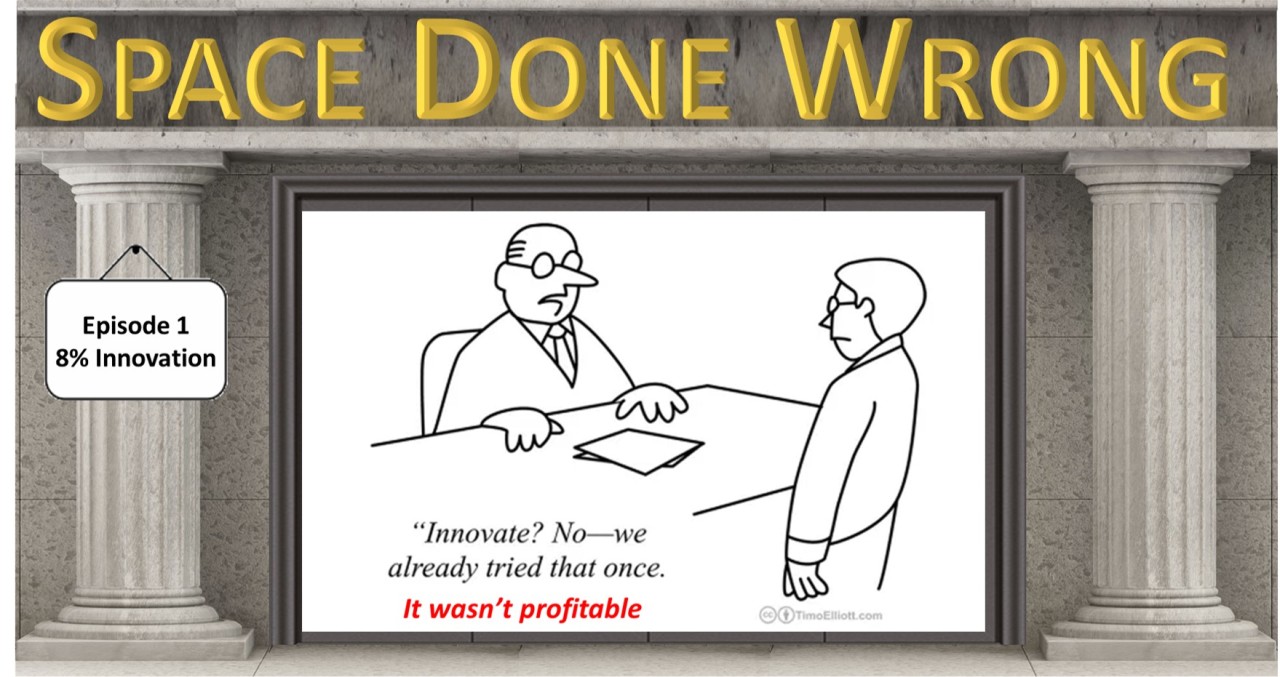
Has your main customer ever rejected your product pricing—which at 50% of the offer from your less innovative competitors is surely the real deal—on the notion that even at this lower price, according to their general contract conditions, you were making too much profit? If not: welcome to #spacedonewrong. Today the world of 8% innovation is brought to you by the pricing model of the space agencies.
Space the final frontier
Many agree that space is the final frontier, and consequently, anything done there is innovative. But is it really? In the space industry, particularly the part driven by government spending, which is also known as #oldspace, innovation is largely absent.
One must wonder, why? Obviously, the standard answer is: “space is hard.” Nobody wants to be left with a broken system at a place where it cannot be reached. While this is true, there are more things to be considered.
Surely, there is money to be made
Let us look at the way business is done in the space industry. Typically, a space agency procures a device, say a satellite, from the industry. This can happen in either two ways: as a cost-plus contract or as a firm-fixed-price contract.

Pay a sombody by the hour, what could possibly go wrong?
In a cost-plus contract, the company is paid for all the effort they had done (material and labor hours) plus a fixed amount of profit—hence the name. This type of contract is usually chosen if there are very high risks involved, and neither party does not know how long and how much it will take. It is rather obvious that any vendor in a cost-plus business is not incentivized to conclude the development soon. Therefore, space agencies learned long ago not to make cost-plus contracts that often.

Your Business, your risk, your profit?
The second type of contract is reserved for the less risky type of business. Here, ideally, multiple vendors make a bid to do a specific task. The agency selects the vendor with the best performance and/or lowest price and pays after delivery the exact asking price. (There are side plays called contract change notices (CCN), which can be an art, but that will be a topic for another day).
The road to hell is paved with good intentions.
However, there are further things at play. In a usual space agency contract, you will find a clause that says the agency has the right to do financial audits. The maximum allowed profit is 7-8% depending on which agency.
A firm-fixed-price that has a cap on profit is instead a cost-plus contract in disguise.
The intention of the agency is clear: its taxpayers’ money. They want to show good stewardship by not allowing the profit to go too high. This is indeed a good intention, but those good intentions are the ones that pave the way to hell.

Welcome to the world of 8% innovation
As an unintended yet very evident result of this 8% profit cap, despite being a firm-fixed contract, you find yourself in a kind of cost-plus situation. Which, as we learned earlier, is not likely to spur innovation.
Space – the one market where innovation is not helping your profits
Let us imagine a well-established space company that has in its inventory a device that could be used for sale to the space agency a second time for a second unit.
A space company has very little incentive to sell it without the NRE because it leads to a decreased price and lower profit.
What happens instead is that the vendor will accept any change request from the agency (until the NRE portion is filled again—e.g., via CCNs) or due to a low number of agency missions outright state, the old version cannot be had anymore.

As a result of this, it is no longer attractive for the vendor to innovate. It is not in the sense of new products (which is a different topic), but most definitely not in terms of process optimization and automation.
How to keep #Newspace at bay
Secondly, let us imagine that the high cost for NRE and testing inspires a #newspace disruptor to develop a device with the same function that is modular and, by design, has very low NRE. Further testing and documentation have been automated so that as a result, it could be sold for the second unit price of the old guard but with very high profit.
Normally this competition would then force the incumbent to innovate as well and to reduce its cost. However, since under the rules of the agency (which is the market’s largest customer), something else happens. Instead of benefiting from its investment, the innovator is now at threat of losing all the “illegal” profit in an audit.
Cobras in Space
What has been created here under agencies rules is a perverse incentive, also known as cobra effect. In short, the understandable desire to cap the profit margin of space companies has created a situation where the existing market participants are paid to be not innovative and innovators (external and internal) are held at bay by fear that their excess profits are being seized.
A perverted incentive, while well intended, achieves something the opposite of what is intended (example: handing out money for slain cobras, and people start breeding cobras to get the money).

Innovation done Right
For the space industry to move forward, this “Space Done Wrong” element needs to be upended. The space industry needs to foster innovation instead of making it undesirable. A true firm-fixed-price with a risk to economically fail and an opportunity to receive the due profit of innovation should be the first step. However, given the deeply conservative and political nature of the space industry, this will be an uphill battle.
I hope that under budget pressure and with success stories in the industry, it will become imperative to change the rules that give us cost-plus in disguise.
Until then, innovation will not happen because it is not profitable.
How can you help:
This text is part of a series of articles in which the author sets the framework to start a discussion about the wrongs of the space industry. If you have experienced similar things, leave a comment. Other views and opinions are very welcome, too, as they may present a way forward. Please be kind to each other.
Disclaimer
The author’s views are his own and do not represent the views of his company Berlin Space Technologies.


Leave a Reply